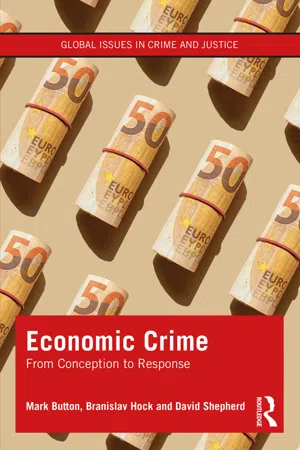
- 298 pages
- English
- ePUB (mobile friendly)
- Available on iOS & Android
About this book
This book is the first attempt to establish 'economic crime' as a new sub-discipline within criminology. Fraud, corruption, bribery, money laundering, price-fixing cartels and intellectual property crimes pursued typically for financial and professional gain, have devastating consequences for the prosperity of economic life. While most police forces in the UK and the USA have an 'economic crime' department, and many European bodies such as Europol use the term and develop strategies and structures to deal with it, it is yet to grain traction as a widely used term in the academic community. Economic Crime: From Conception to Response aims to change that and covers:
- definitions of the key premises of economic crime as the academic sub-discipline within criminology;
- an overview of the key research on each of the crimes associated with economic crime;
- public, private and global responses to economic crime across its different forms and sectors of the economy, both within the UK and globally.
This book is an essential resource for students, academics and practitioners engaged with aspects of economic crime, as well as the related areas of financial crime, white-collar crime and crimes of the powerful.
Frequently asked questions
- Essential is ideal for learners and professionals who enjoy exploring a wide range of subjects. Access the Essential Library with 800,000+ trusted titles and best-sellers across business, personal growth, and the humanities. Includes unlimited reading time and Standard Read Aloud voice.
- Complete: Perfect for advanced learners and researchers needing full, unrestricted access. Unlock 1.4M+ books across hundreds of subjects, including academic and specialized titles. The Complete Plan also includes advanced features like Premium Read Aloud and Research Assistant.
Please note we cannot support devices running on iOS 13 and Android 7 or earlier. Learn more about using the app.
Information
Chapter 1Economic crime and economic criminology
Introduction
Boris Johnson pledges to target crime and anti-social behaviour– BBC NewsFreed burglars to wear 24-hour tags under Prime Minister’s Crime Crackdown– TelegraphThieves tagged 24-hours a day and crooks forced to clean streets in crime crackdown– Express
White-collar crime and corruption
White-collar crime
White-collar crime may be defined approximately as a crime committed by a person of respectability and high social status in the course of his occupation.(Sutherland, 1949, p. 9)
- White-collar criminals are respectable offenders.
- Their offences involve an abuse of trust.
- Their criminal activities are integrated into their professional work routines.
Table of contents
- Cover
- Endorsement Page
- Half-Title Page
- Series Page
- Title Page
- Copyright Page
- Table of Contents
- List of Figures
- List of Tables
- About the authors
- Acknowledgements
- List of abbreviations
- Chapter 1 Economic crime and economic criminology
- Chapter 2 Fraud
- Chapter 3 Bribery and corruption
- Chapter 4 Cartel and antitrust offences
- Chapter 5 Economic cybercrime
- Chapter 6 Intellectual property crime and illicit trade
- Chapter 7 Industrial and economic espionage
- Chapter 8 Money laundering
- Chapter 9 Explaining economic crime
- Chapter 10 Economic crime: law and regulation
- Chapter 11 State and transnational policing of economic crime
- Chapter 12 Private policing of economic crime
- Conclusion: An agenda for economic criminologists and economic crime practitioners
- Index